Welcome to the essential guide for navigating the world of code. Choosing your first or next programming language is a pivotal career decision. With technology evolving faster than ever, from artificial intelligence and machine learning to immersive web experiences, the demand for skilled developers is booming across the United States, Pakistan, and globally. But with so many options, which is the easiest programming language for beginners?
This article cuts through the noise to help you confidently select which language to learn. We’ll explore some of the best programming languages to learn, breaking down each one by its real-world applications, current job market demand, and typical learning curve. We also spotlight the top learning platforms like Coursera and freeCodeCamp, providing direct links to help you begin immediately.
Whether your goal is to build dynamic websites, analyze complex data sets, or develop the next breakthrough mobile app, this guide provides the clarity needed to invest your time wisely. Consider this your roadmap to finding the right language and the best learning resources, such as Codecademy or Udemy, to kickstart your coding journey and advance your career in tech. Let’s dive into the most in-demand programming languages.
1. freeCodeCamp
freeCodeCamp stands as a monumental resource for anyone eager to learn programming, offering an extensive, project-based curriculum entirely for free. This non-profit organization has built a global community around a simple yet powerful mission: to make high-quality tech education accessible to everyone. Whether you’re a complete beginner aiming to learn your first language or a seasoned developer looking to pick up a new skill, freeCodeCamp provides a structured pathway to help you master some of the best programming languages to learn, including JavaScript, Python, and SQL. This makes it a top choice for learning to code for free.
The platform’s strength lies in its hands-on approach. You don’t just watch videos; you actively code in an interactive, in-browser editor, applying concepts immediately through thousands of challenges and tutorials. This self-paced structure is ideal for learners who need flexibility.
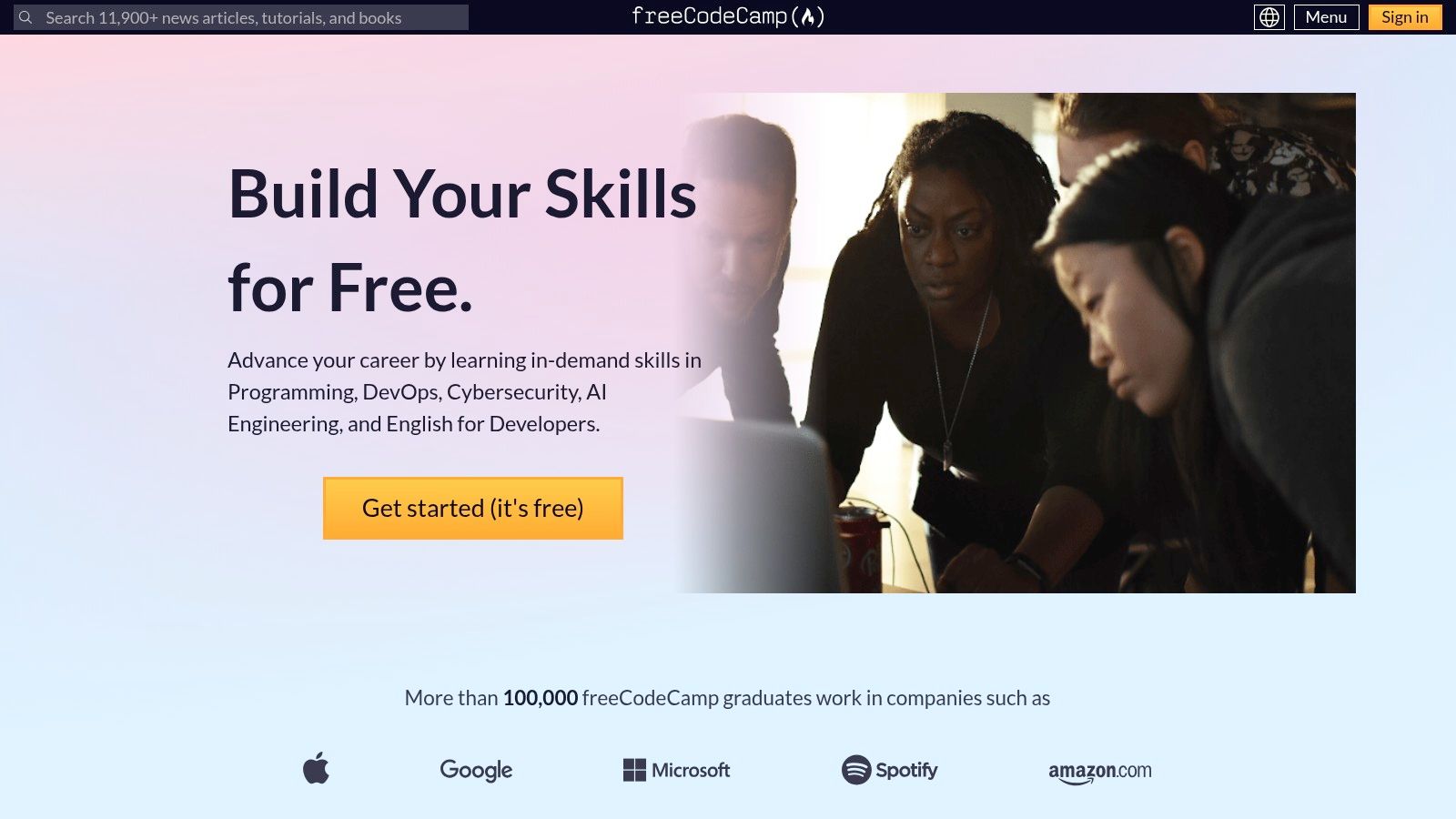
Key Features and Offerings
freeCodeCamp’s curriculum is comprehensive, guiding you from basic HTML and CSS to complex backend development and machine learning concepts. The platform is particularly known for its certifications, which are awarded after completing a series of real-world projects.
- Curriculum Structure: Over 11 core certifications cover topics like Responsive Web Design, JavaScript Algorithms, Data Visualization, and Scientific Computing with Python.
- Real-World Experience: The final certifications challenge you to build projects for non-profit organizations, providing invaluable portfolio pieces and practical experience.
- Community Support: A massive, active forum and community chat rooms offer peer support, code reviews, and a place to network with fellow learners.
Pros and Cons
| Pros | Cons |
|---|---|
| Completely Free: No hidden fees or subscriptions. All content, projects, and certifications are accessible without charge. | Requires Self-Discipline: The self-paced nature means you must stay motivated without direct instructor oversight. |
| Project-Based Learning: Builds a strong portfolio with practical, real-world applications. | Limited Personalized Feedback: While community support is strong, you won’t receive one-on-one mentorship. |
| Recognized Certifications: The certifications are well-regarded and can bolster a resume or LinkedIn profile. | Broad Scope Can Be Overwhelming: The sheer volume of content can be daunting for new learners without a clear goal. |
Ultimately, freeCodeCamp’s commitment to providing free, high-quality education makes it an unparalleled starting point for anyone exploring the top programming languages in demand today.
Website: https://www.freecodecamp.org
2. Codecademy
Codecademy is a premier online learning platform celebrated for its interactive, hands-on approach to coding education. It excels at guiding beginners through their first lines of code and provides structured pathways for those looking to switch careers or upskill. The platform’s core philosophy is learning by doing, making it an excellent resource for mastering some of the best programming languages to learn, such as Python, JavaScript, Java, and SQL, directly within your browser. If you’re wondering what programming language to learn first, Codecademy’s gentle introduction is a great option.
What sets Codecademy apart is its highly polished, user-friendly interface that provides instant feedback. As you type code, the system immediately tells you if it’s correct, helping to reinforce concepts and prevent bad habits. This interactive loop is perfect for learners who thrive on immediate gratification and clear, step-by-step instructions.
Key Features and Offerings
Codecademy’s strength lies in its meticulously designed “Career Paths” and “Skill Paths,” which bundle courses and projects to prepare you for specific job roles like Front-End Engineer, Data Scientist, or Full-Stack Engineer. This makes it easy to find a learning roadmap for the top programming languages relevant to your goals.
- Interactive Learning Environment: Write and run code directly in the browser with an editor that provides real-time checks and helpful hints.
- Structured Paths: Follow curated learning paths that combine courses, quizzes, and portfolio-worthy projects to build job-ready skills.
- Real-World Projects: Apply your knowledge by building functional applications, such as a personal website or a data analysis program, to solidify your learning and enhance your portfolio.
- Quizzes and Assessments: Test your understanding at every step with integrated quizzes, ensuring you have a solid grasp of the material before moving on.
Pros and Cons
| Pros | Cons |
|---|---|
| User-Friendly Interface: Exceptionally easy for absolute beginners to get started without complex setup. | Advanced Content Requires Subscription: While basic courses are free, in-depth content and career paths are behind the Pro paywall. |
| Immediate Feedback: The instant code validation helps learners correct mistakes quickly and understand concepts better. | Limited Depth in Free Courses: The free-tier courses often provide a surface-level introduction, encouraging an upgrade for deeper knowledge. |
| Wide Range of Languages: Covers an extensive catalog of languages and tech skills, from web development to data science. | Less Community-Driven: While there are forums, it lacks the massive, peer-driven support network found on platforms like freeCodeCamp. |
For learners who value a structured, guided, and highly interactive experience, Codecademy offers one of the most effective and engaging ways to start your journey with programming languages.
Website: https://www.codecademy.com
3. Coursera
Coursera brings university-level education directly to your screen, partnering with over 200 leading universities and companies like Google, IBM, and Stanford. It provides a structured, academic environment for learning some of the best programming languages to learn, from Python for data science to Java for software engineering. This platform is ideal for those who value a formal curriculum and recognized credentials from prestigious institutions, making it a great place to find coding courses online.
The platform offers a blend of on-demand video lectures, auto-graded quizzes, and peer-reviewed assignments, creating an interactive and rigorous learning experience. You can choose to audit many courses for free to access the material or pay for a course or specialization to earn a professional certificate.
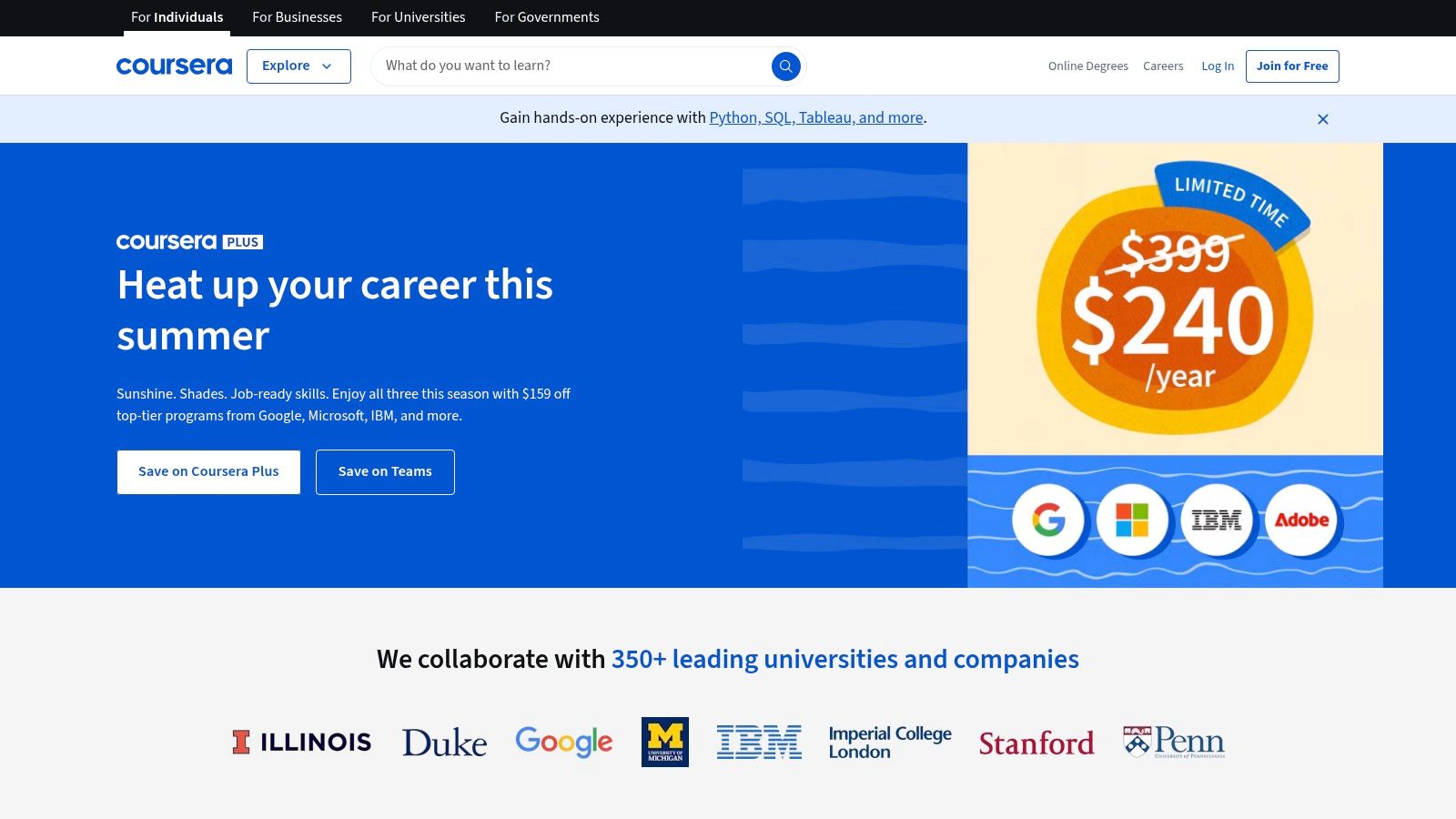
Key Features and Offerings
Coursera stands out by offering courses that are often identical to those taught on-campus. The platform’s specializations and professional certificates provide a clear pathway from foundational knowledge to job-ready skills in today’s top programming languages.
- University-Backed Courses: Learn directly from top professors at world-class universities, ensuring high-quality, academically sound content.
- Professional Certificates: Earn career-focused credentials from industry leaders like Google, Meta, and IBM, designed to prepare you for in-demand jobs.
- Flexible Learning Paths: Enroll in individual courses, multi-course specializations, or even full online degree programs, all with self-paced schedules.
Pros and Cons
| Pros | Cons |
|---|---|
| Prestigious Credentials: Certificates are co-branded with respected institutions, adding significant value to your resume. | Cost for Certification: Accessing graded assignments and earning a certificate requires payment, which can be a barrier for some. |
| Structured, High-Quality Content: The curriculum is well-organized and academically rigorous, providing deep theoretical knowledge. | Variable Course Quality: While most courses are excellent, quality can sometimes vary between different institutions and instructors. |
| Audit Option for Free Learning: You can access most course lectures and readings for free by choosing the audit option. | Less Community Interaction: While forums exist, the community feel is less integrated than platforms like freeCodeCamp. |
For learners seeking a formal, university-aligned approach to mastering the best programming languages to learn, Coursera offers an unparalleled library of high-caliber courses and certifications.
Website: https://www.coursera.org
4. Udemy
Udemy is a massive online learning marketplace that offers an unparalleled selection of courses on virtually every programming topic imaginable. Unlike structured, singular curriculum platforms, Udemy’s strength lies in its diversity. It hosts thousands of individual courses created by independent instructors, giving learners access to various teaching styles, perspectives, and specializations. This makes it an excellent resource for finding in-depth training on the best programming languages to learn, from popular choices like Python and JavaScript to more niche languages. It’s a key destination for anyone looking to learn programming online.
The platform operates on a pay-per-course model, which means once you purchase a course, you have lifetime access to it. This flexibility allows you to learn at your own pace without the pressure of a monthly subscription, making it a great choice for professionals and hobbyists who need to fit learning into a busy schedule.
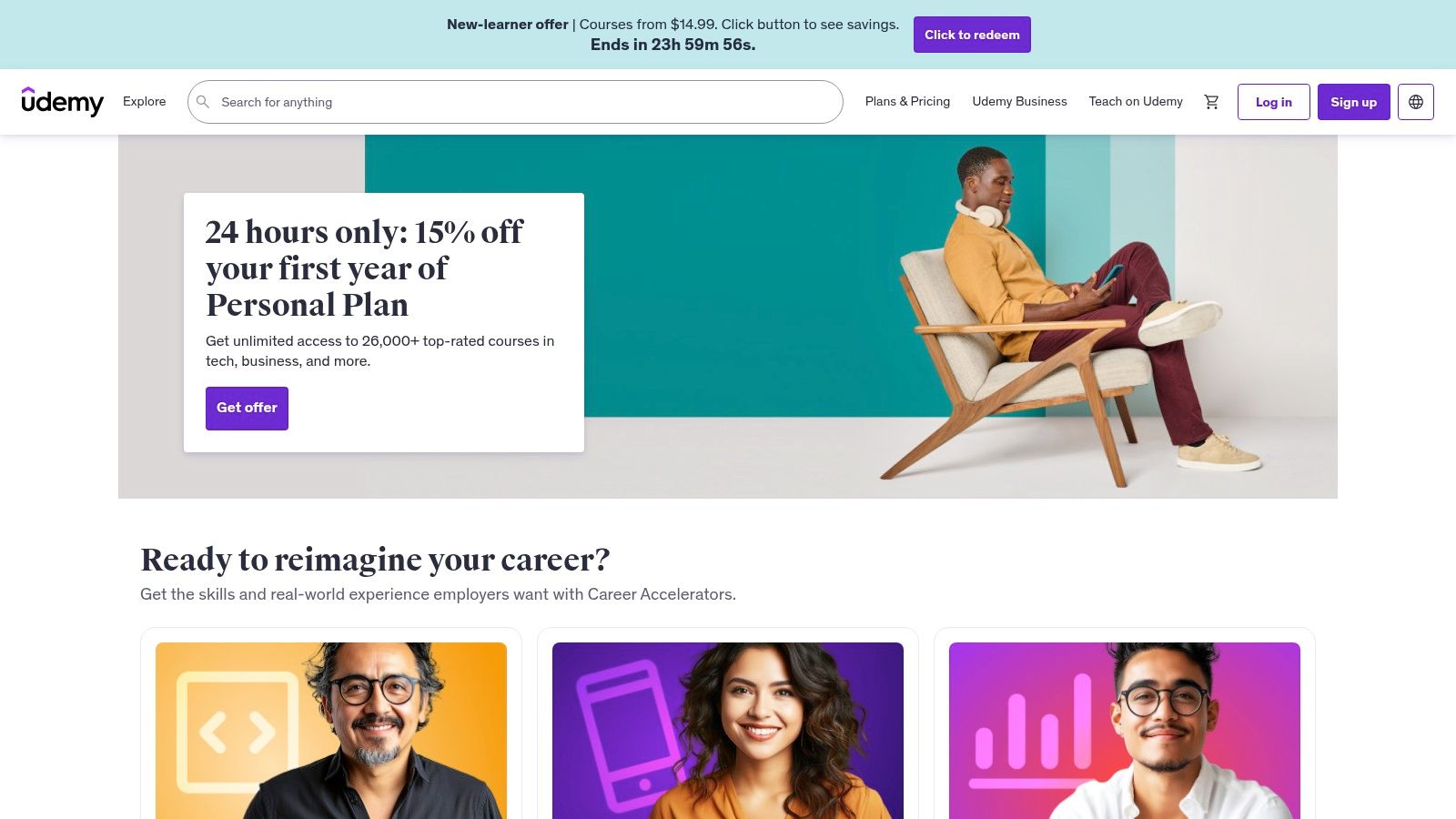
Key Features and Offerings
Udemy’s vast library is its defining feature, covering not just introductory content but also advanced and specialized topics that are hard to find elsewhere. Courses often include video lectures, coding exercises, quizzes, and project-based assignments to ensure a comprehensive learning experience.
- Extensive Course Library: Choose from over 200,000 courses on subjects ranging from web development and mobile app creation to data science and ethical hacking.
- Lifetime Access: Pay once for a course and access its content forever, including any future updates the instructor adds.
- Practical Learning Tools: Many courses include downloadable resources, source code, and practical exercises to reinforce concepts.
- User-Driven Quality: A robust review and rating system helps you identify the highest-quality courses based on the experiences of millions of other students.
Pros and Cons
| Pros | Cons |
|---|---|
| Wide Variety of Courses: The sheer volume of content means you can find a course on almost any programming language or technology. | Quality Varies: Since instructors are independent, the quality of teaching and course production can be inconsistent. |
| Affordable Pricing: Frequent and deep discounts make even premium courses highly accessible, often for under $20. | No Formal Accreditation: While certificates of completion are provided, they are not formally accredited and carry less weight than a university degree. |
| Learn at Your Own Pace: Lifetime access and self-paced lessons provide complete flexibility for your learning journey. | Can Be Overwhelming: The number of choices can make it difficult for beginners to select the right starting course. |
For learners who want a wide selection and the freedom to choose their own path, Udemy offers an affordable and flexible way to master the top programming languages and stay current with tech trends. To get the most value, always check user reviews and wait for one of their frequent sales events.
Website: https://www.udemy.com
5. W3Schools
W3Schools is a legendary and highly accessible resource for anyone starting their journey with web development. It offers a vast library of free tutorials and references covering core web technologies, making it an excellent platform to learn some of the best programming languages to learn, such as JavaScript, Python, SQL, and C++. Its straightforward, no-frills approach focuses on providing clear explanations and immediate, hands-on practice. It’s often the first stop for beginners wanting a simple programming tutorial.
The platform’s standout feature is its simplicity and directness. Learners can dive into a topic, read a concise explanation, and immediately experiment with code in an interactive “Try it Yourself” editor, all within their browser and without needing to register. This frictionless experience is perfect for quick lookups or for beginners who want to grasp fundamental concepts without feeling overwhelmed.
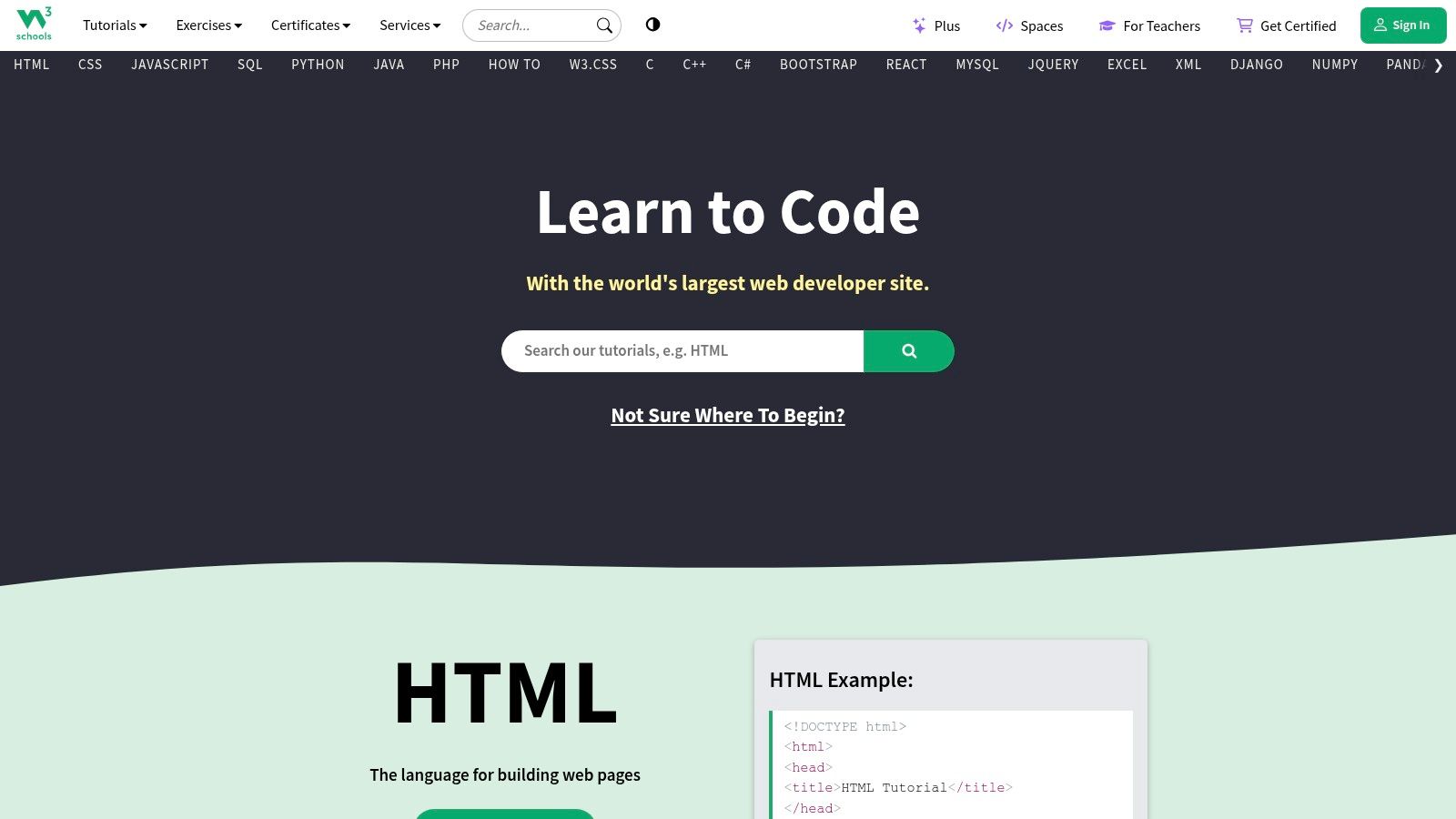
Key Features and Offerings
W3Schools is structured more like a comprehensive encyclopedia than a linear course, allowing you to jump directly to the information you need. This makes it an invaluable companion for both learning and on-the-job problem-solving.
- Interactive Learning: The “Try it Yourself” editor is embedded in almost every tutorial, allowing for instant code modification and execution to see how changes affect the output.
- Comprehensive References: Detailed reference materials for languages like HTML, CSS, JavaScript, and Python are organized for quick access, serving as a go-to resource for developers.
- Quizzes and Exercises: Each module includes quizzes and exercises to test your understanding and reinforce key concepts, helping to solidify your knowledge.
Pros and Cons
| Pros | Cons |
|---|---|
| Completely Free Access: All tutorials, examples, and reference materials are available without any cost or registration. | Lacks Advanced Depth: While excellent for beginners, it may not cover complex, advanced topics in great detail. |
| Beginner-Friendly: The content is broken down into simple, digestible pieces, ideal for those new to programming. | No Formal Certifications: Unlike other platforms, it does not offer widely recognized, project-based certifications. |
| Instant Practice: The integrated code editor provides immediate, hands-on experience without any setup. | Limited Community Interaction: The focus is on self-study, with less emphasis on community forums or peer support. |
For those looking for a quick, reliable, and free way to get started with the top programming languages or refresh their knowledge on a specific concept, W3Schools remains an indispensable tool in the developer’s arsenal.
Website: https://www.w3schools.com
6. Exercism
Exercism offers a unique, hands-on approach to mastering programming languages through practice, feedback, and mentorship. As a non-profit, open-source platform, it provides a space for developers to hone their skills in over 70 different languages, making it a fantastic resource for learning some of the best programming languages to learn today. The core philosophy of Exercism is that proficiency comes from practice and receiving guidance from those with more experience. This is one of the best ways to learn coding if you prefer a hands-on method.
The platform distinguishes itself with its mentorship model. After solving a coding challenge, you can submit your solution for review by a volunteer mentor, who provides personalized feedback to help you improve your code quality, understand idiomatic expressions, and deepen your grasp of the language. This cycle of practice and refinement is invaluable for skill development.
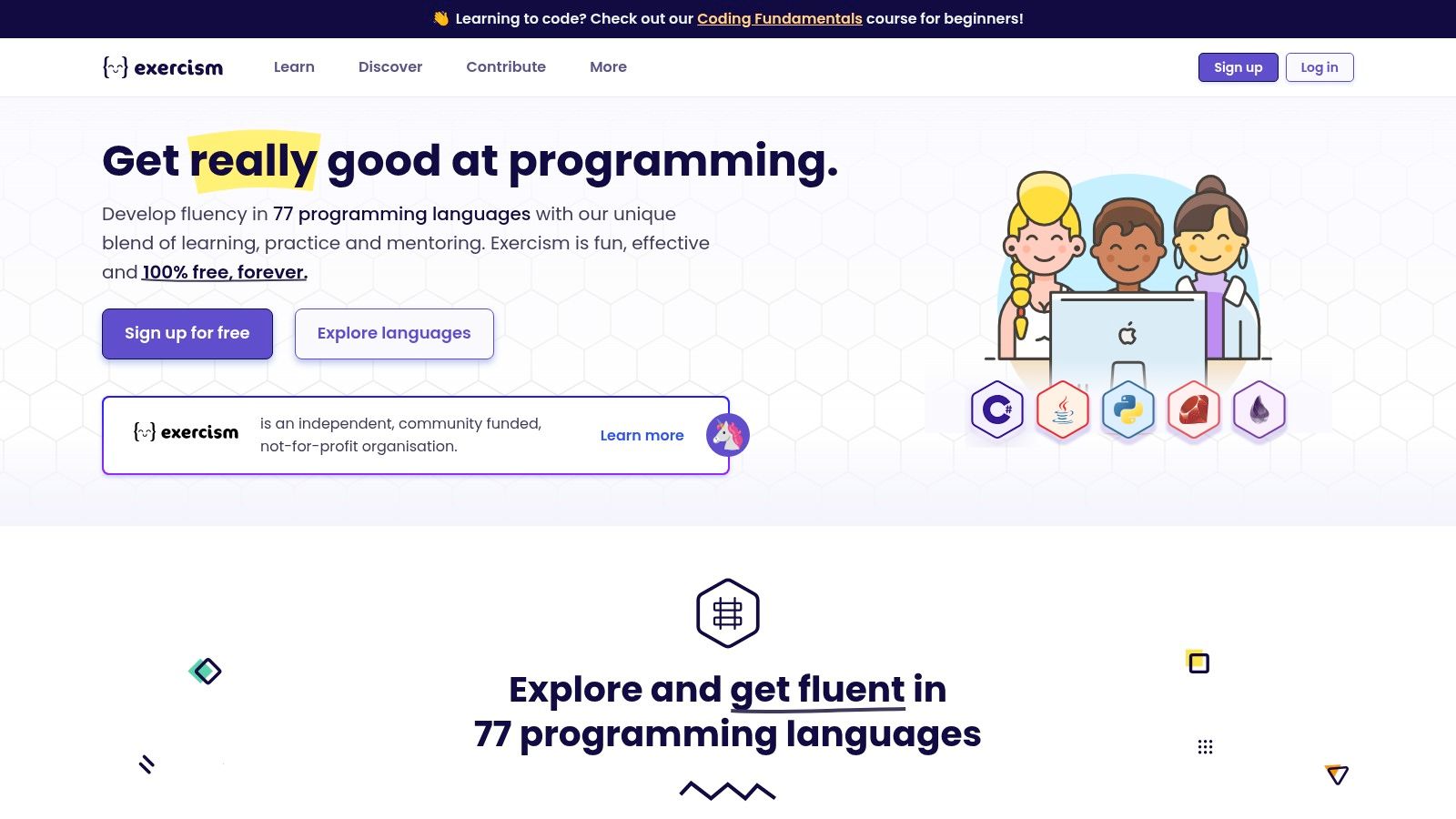
Key Features and Offerings
Exercism is built around structured learning paths, or “tracks,” for each language. These tracks contain a series of coding exercises that gradually increase in difficulty, allowing you to build your fluency one concept at a time. The platform is entirely community-driven, from the exercises themselves to the mentorship.
- Language Tracks: Choose from over 70 language tracks, including popular choices like Python, Go, Rust, and JavaScript, each with its own curated set of exercises.
- Human Mentorship: Submit your code and receive personalized feedback from experienced developers. This one-on-one interaction is rare for a free platform.
- Community-Driven: All content is open source and maintained by a global community, ensuring a wide variety of high-quality, practical coding challenges.
Pros and Cons
| Pros | Cons |
|---|---|
| Completely Free: The entire platform, including all exercises and mentorship, is available at no cost. | Mentorship Varies: As mentors are volunteers, the availability and speed of feedback can differ depending on the language track and demand. |
| Personalized Feedback: The mentorship system provides deep, actionable insights that automated tests cannot. | Challenging for Absolute Beginners: While it has beginner exercises, the platform assumes some basic coding knowledge and may feel less guided than tutorial-based sites. |
| Wide Language Support: An incredible selection of languages lets you explore mainstream and niche options alike. | Requires Proactive Learning: You must actively seek feedback and engage with the platform to get the most out of it. |
For learners who want to move beyond tutorials and truly test their problem-solving skills, Exercism provides an unparalleled environment for deliberate practice and growth in the top programming languages.
Website: https://exercism.org
7. Codewars
Codewars takes a unique, gamified approach to mastering programming by immersing users in a world of coding challenges known as “kata.” Instead of traditional lessons, this platform sharpens your skills through practice, competition, and peer collaboration. It stands out by treating coding like a martial art, where you refine your technique by solving progressively harder problems. This makes it an excellent resource for learners who want to test their knowledge of the best programming languages to learn, from Python and JavaScript to more niche languages like Rust and Haskell. It is an excellent platform for coding for beginners who enjoy a challenge.
The platform’s core philosophy is learning through doing. You are presented with a challenge, you solve it in an integrated online editor, and then you compare your solution with others from the community. This process not only validates your understanding but also exposes you to more efficient or creative ways to tackle the same problem, accelerating your growth as a developer.
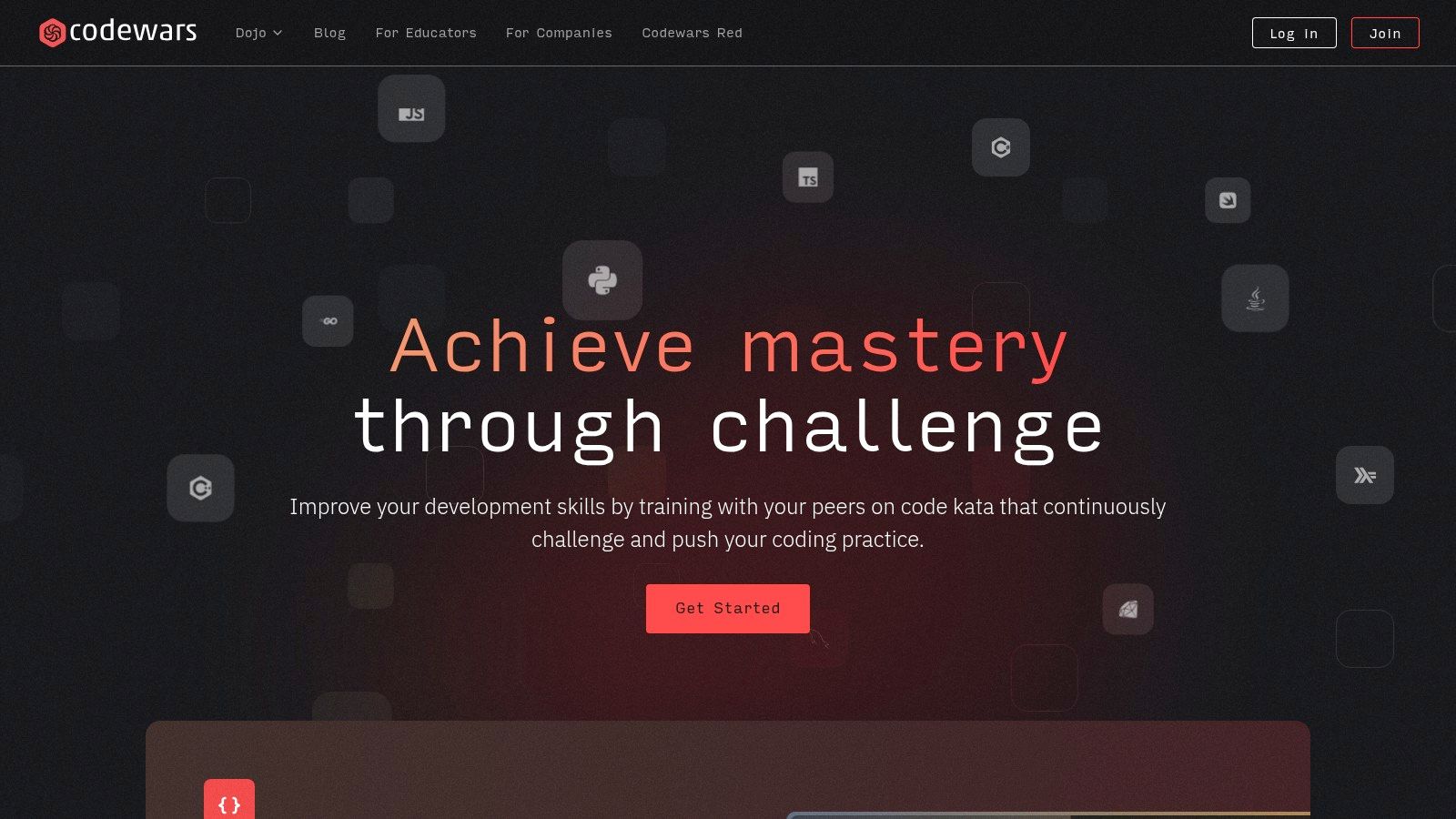
Key Features and Offerings
Codewars is built around its community and a system of continuous improvement. The kata are created and refined by users, ensuring a fresh and relevant pool of challenges that reflect real-world programming scenarios.
- Gamified Ranking: You start as a novice (8 kyu) and advance to master (1 kyu) by completing kata. This honor system provides clear motivation and a tangible sense of progress.
- Broad Language Support: Codewars supports over 55 programming languages, allowing you to practice in your preferred language or pick up a new one.
- Community-Driven Solutions: After solving a kata, you gain access to a feed of solutions submitted by other users, which you can filter by “Best Practices” or “Clever.” This is a powerful learning tool for discovering new techniques.
- Integrated Development Environment (IDE): You can write, test, and submit your code directly in the browser, complete with a testing framework to validate your solution against edge cases.
Pros and Cons
| Pros | Cons |
|---|---|
| Engaging and Competitive: The gamified system and peer rankings make practice feel like a challenging game. | Intimidating for Beginners: Lacks foundational lessons, which can make it difficult for those with no prior coding experience. |
| Wide Range of Challenges: Offers thousands of kata, from simple functions to complex algorithms, catering to all skill levels. | Focuses on Practice, Not Instruction: It’s a platform for honing skills, not for learning the top programming languages from scratch. |
| Excellent for Interview Prep: The problem-solving nature of kata is perfect for preparing for technical interviews. | Solution Quality Varies: Since solutions are community-submitted, some may not represent best practices. |
Codewars is a fantastic, free platform for developers who want to move beyond theory and put their skills to the test in a fun, competitive environment. It is an ideal supplement to more structured courses.
Website: https://www.codewars.com
Top 7 Coding Platforms Comparison
| Platform | 🔄 Implementation Complexity | 💡 Resource Requirements | 📊 Expected Outcomes | 💡 Ideal Use Cases | ⭐ Key Advantages |
|---|---|---|---|---|---|
| freeCodeCamp | Moderate – self-paced, structured curriculum | Low – free access to all materials | Practical skills via hands-on projects, certifications | Beginners to advanced learners seeking comprehensive, free training | Completely free, real-world projects, recognized certifications |
| Codecademy | Low to Moderate – interactive lessons with structured paths | Medium – free and paid plans available | Skill building with immediate feedback, portfolio projects | Beginners wanting guided, interactive learning with feedback | User-friendly, wide language coverage, immediate feedback |
| Coursera | Moderate to High – university-level courses, some fixed schedules | Medium to High – payment required for certificates | University-backed knowledge, certifications, peer-reviewed work | Learners seeking credible certifications and academic rigor | Prestigious institution partners, flexible learning options |
| Udemy | Low – on-demand courses of varying quality | Low to Medium – pay per course, often discounted | Varied outcomes depending on course quality and instructor | Self-paced learners seeking affordable options across topics | Huge course variety, lifetime access, affordable pricing |
| W3Schools | Low – concise tutorials and examples | Low – free access, no registration needed | Basic to intermediate knowledge in web technologies | Absolute beginners needing quick, accessible tutorials | Free, beginner-friendly, no signup required |
| Exercism | Moderate – coding exercises with mentorship | Low – free access, mentorship varies | Skill improvement with personalized feedback | Coders seeking mentorship and practice across many languages | Free, personalized feedback, broad language coverage |
| Codewars | Moderate to High – challenge-based practice, gamified system | Low – free usage with community support | Improved coding skills through repeated practice | Developers wanting competitive, challenge-focused learning | Gamified, community-driven, wide challenge variety |
Your Next Step: From Learning to Earning
Choosing one of the best programming languages to learn is a significant first step, but it’s the journey that follows which forges a successful career in tech. The path from novice coder to professional developer is paved with consistent practice, hands-on projects, and a commitment to continuous learning. The tools we’ve explored, from freeCodeCamp’s project-based curriculum to Coursera’s university-backed specializations and Exercism’s mentored practice, provide the structured support you need to master your chosen language.
The key takeaway is that the “best” language is ultimately a personal choice, deeply tied to your interests and career aspirations. Each language we’ve discussed unlocks a unique set of opportunities.
- For the AI & Data Enthusiast: Python, paired with SQL, remains the undisputed champion. Its extensive libraries for machine learning and data analysis make it the go-to for anyone looking to build intelligent systems.
- For the Web Architect: JavaScript is non-negotiable for front-end development, while TypeScript adds the safety and scalability modern applications demand.
- For the Systems & Performance Engineer: Rust offers unparalleled memory safety and speed for high-performance applications, while Go provides concurrency and scalability for backend services.
- For the Mobile Innovator: Kotlin is the modern, pragmatic choice for building robust and elegant Android applications.
Turning Knowledge into Action
The most critical phase of your learning journey begins now. Reading about coding is not the same as writing code. To truly cement your skills, you must move from passive learning on platforms like Udemy and W3Schools to active creation.
Your actionable next steps should be:
- Define a Simple Project: Don’t aim to build the next Facebook. Start with a small, manageable goal like a personal portfolio website, a simple to-do list app, or a script to automate a daily task. This provides a clear objective and immediate application for your new skills.
- Embrace “Deliberate Practice”: Use tools like Codewars and Exercism to tackle challenges that are just outside your comfort zone. This method of pushing your boundaries is proven to accelerate learning far more effectively than simply repeating what you already know.
- Build in Public: Share your progress on platforms like GitHub or a personal blog. This not only creates a portfolio to show potential employers but also invites feedback and connects you with the wider developer community.
Making the right choice from this list of the best programming languages to learn requires self-reflection. Ask yourself: what problems do I want to solve? What industries excite me? Answering these questions will guide you to the language and learning path that not only lands you a job but builds a fulfilling, long-term career. The best time to start was yesterday; the next best time is right now.
Ready to dive deeper and accelerate your tech journey? At Mubashar Tech Talk, we provide in-depth tutorials, industry news, and expert guides on these programming languages and more. Visit Mubashar Tech Talk to find the resources you need to turn your learning into a career.





![Infinix Note 40 Price in Pakistan – Full Specs, Features & Reviews [2025]](https://mubashartechtalk.com/wp-content/uploads/2025/07/Infinix-Note-40-price-in-pakistan-2025-150x150.jpg)




